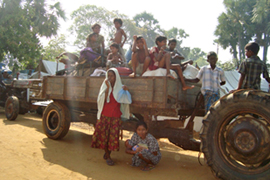Trapped Sri Lankans face starvation
Tamil Tigers and government say non-combatants in conflict zone face “imminent” starvation.

The Liberation Tigers of Tamil Eelam (LTTE) said in a statement on Saturday that food stocks had dwindled, making starvation “imminent”.
They have called on the UN and the international community to ensure that supplies are swiftly sent to the area where an estimated 50,000 people remain.
“We fear that further delay can result in a crisis similar to that faced in Darfur or even deadlier,” the group said in a statement published on the rebel-allied TamilNet website.
Dire situation
The civilians’ dire situation has deteriorated in recent days with the Sri Lankan military pressing ahead with its offensive to destroy the LTTE in a war that has been raging for a quarter of a century.
| Focus: Sri Lanka | ||||||||||

|
Al Jazeera’s David Chater, reporting from Sri Lanka, said: “We have heard from many people that humanitarian supplies still around were being taken by the Tamil Tigers and sold to the people [displaced by fighting].
“Many of the people I saw were in an advanced state of dehydration. Many of the older people were extremely malnourished and you can only imagine what it is like for the children trapped inside the conflict zone.”
He said that the camps for internally displaced people had received a “huge influx” – more than 100,000 in just one week – and they “definitely need help as well not only from the UN but also from any government that can bring aid to them”.
“It is a desperate situation for those who have just escaped and the Tigers said it was equivalent to Darfur and might even be deadlier,” Chater reported.
A Tamil television channel in Canada has released a video which reportedly shows a Sri Lankan warplane dropping bombs as civilians shelter in trenches.
The channel says the pictures were shot on Friday and Saturday, when the air force carried out 25 air attacks inside the war zone.
But speaking to Al Jazeera, a spokesman for the air force denied the charges, saying that aircraft in the area are only conducting surveillance.
Medicine shortage
Aid workers say more than 100,000 civilians have fled the tiny coastal strip still under the control of the LTTE, flooding hospitals in the north and overwhelming government-run camps for the displaced.
 |
| Civilians remaining in the conflict zone are believed to be without sufficient food [AFP] |
Dr Gnana Gunalan, director of health services in Trincomalee district and former chairman of Sri Lanka Red Cross, told Al Jazeera that the displaced people he saw had starved for days and were malnourished and needed food.
“Their first priority is food. Everybody is asking for food,” he said.
The UN says at least 50,000 civilians remain caught in the war zone.
Weiss said that refugees leaving the region over the past week had given a grim picture of the conditions there.
“These people are emaciated, exhausted, they have clearly been denied sufficient supplies of food and medicine,” he told Al Jazeera.
“Over the past three months there are significant numbers of severe casualties amongst these people. They have suffered artillery bombardment, small arms fire. Many of them were injured coming out, when they encountered mine fields and booby-traps.”
The Tamil Tigers says the number of civilians is three times that estimated by the UN.
Thousands killed
The government has barred aid groups and journalists from the area since last year, arguing that it is too dangerous for them.
Marie Okabe, the UN deputy spokeswoman, said that the humanitarian situation “continues to be critical, civilian casualties have been tragically high and their suffering horrendous”.
The UN says nearly 6,500 civilians have been killed in the fighting over the past three months.
The Tigers, listed as a terror group by many Western nations, have been fighting since 1983 for an ethnic Tamil state in the north and east after decades of what they call marginalisation by governments dominated by the Sinhalese majority.
After more than three years of intense fighting, the government appears on the verge of crushing the group.
Riding a wave of popularity from its war success, Sri Lanka’s ruling party appeared the favorite to win Saturday’s council election in the Western province.
